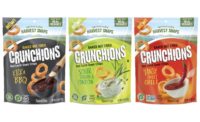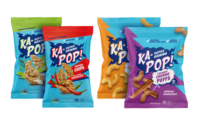Snack Food & Wholesale Bakery had the chance to attend THAIFEX this year, held at the IMPACT convention center in Bangkok, Thailand. The show had 2,537 exhibitors, and 62,039 visitors, from over 150 countries (48,929 local, and 13,110 from international). The top ten most visiting countries included China, Korea, Taiwan, Japan, Malaysia, Vietnam, Italy, Singapore, Turkey, and India.
There were 11 halls in total, and one of the halls had many, many rows of snack foods and bakery items. Trends ranged from better-for-you products (broccoli chips, coconut chips, etc.) to interesting flavors that you might not see in the U.S.—for example, durian-flavored products are quite popular there, as well as flavors like Tom Yum popcorn. Check out the above slideshow to see what we came across at the show.
Some information on Thailand and its snack industry, from THAIFEX:
- Thailand has long been called “the kitchen of the world” with its abundant natural resources, a year-round growing season, highly-skilled workforce, and strength in research. Thailand enjoys numerous competitive advantages in the food and agricultural industries. Roughly 50 percent of total land area in the country is used for agricultural purposes, allowing over 80 percent of raw materials to be used in the food industry which can be sourced locally at competitive prices. The country is a top-ten global producer of some important agricultural products including rice, cassava, sugarcane, palm oil, coconut, pineapple, and natural rubber. The food industry contributed roughly 21.1 percent of the country’s GDP or 914,639 million baht. Making the food ranked number 1 of the key industry in Thailand, followed by electric and electronic, automobile, chemical, textile and apparel, respectively.
(*Data and figure from Food Intelligence Center Thailand)
- Thailand is also one of the largest net food exporting countries in the world and the second in Asia and stands proud among world’s leading exporters of rice, sugar, seafood, fruits and vegetables and other commodities. Exports of processed foods are also performing well and growing.
- Organic products are an emerging but increasingly important category in Thailand. Consumers are more sophisticated and becoming aware of the benefits of organic foods. Almost 300,000 rai (118,610 acres) in Thailand are being used for organic agriculture. Thailand’s organic consumption was valued at USD 15 million in 2016. Organic rice is the largest sector, accounting for 65 percent of the total organic food market. Organic coffee and green tea had the highest growth among beverages at 8.9 percent and 7.3 percent, respectively, from 2011- 2016. Organic products from Thailand are exported and sold in many well-known global supermarket chains and organic-focused retailers such as Whole Foods Market and Wal-Mart.
- The total exports of food products for 2018 stood at Bt1.031 trillion (USD 32,190 million), growing by 7.3 percent compared to previous year.
- In 2018, rice took up the largest portion of total food exports, valued at Bt180.116 billion and growing by 17.5 per cent year on year.
- In 2017, Thailand ranked as the world’s number 14 largest food exporter and shared 2.3 percent of the world’s total export of food. The country ranked world’s number 1 exporter of tuna fish, cassava, and processed pineapple, and also ranked world’s number 2 exporter of rice and sugar.











































































.jpg?height=200&t=1637184850&width=200)